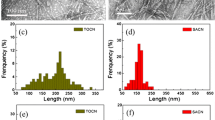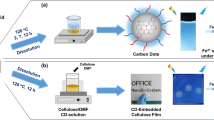Abstract
As functional materials, luminescent films have a wide range of applications in terms of displays, light-emitting devices, safety signs and sensors. Cellulose is the most abundant renewable resource in the world and plays an important role in the field of membrane synthesis. Here, cellulose was dissolved in 7 % NaOH/12 % urea aqueous solution, and the regenerated cellulose films were prepared in acid media. N and S doping carbon quantum dots (C-QDs) were synthesized as the high-efficiency luminescent materials, and the nanocomposite films of cellulose/C-QD were prepared by fixing the C-QDs onto the surface of regenerated cellulose fibers. Fourier transform infrared spectrometry, X-ray diffraction, atomic force microscopy and scanning electron microscopy measurements were used to measure the structure and properties of the film. The as-prepared film was transparent and luminescent in the visible region with high mechanical strength. In addition, no metal was involved in the luminescent film, which makes it safe and lightweight, and the film has potential applications in many fields.
Graphical abstract
Metal-free cellulose/carbon QDs composite film was prepared, and the film was highly transparent and luminescent.












Similar content being viewed by others
References
Abitbol T, Gray D (2007) CdSe/ZnS QDs embedded in cellulose triacetate films with hydrophilic surfaces. Chem Mater 19(17):4270–4276
Abitbol T, Gray DG (2009) Incorporation into paper of cellulose triacetate films containing semiconductor nanoparticles. Cellulose 16(2):319–326
Abitbol T, Wilson JT, Gray DG (2009) Electrospun fluorescent cellulose triacetate fibers containing quantum dots. Abs Am Chem Soc 237:185–186
Biju V (2014) Chemical modifications and bioconjugate reactions of nanomaterials for sensing, imaging, drug delivery and therapy. Chem Soc Rev 43(3):744–764
Buck MR, Biacchi AJ, Popczun EJ, Schaak RE (2013) Polymer-assisted synthesis of colloidal germanium telluride nano-octahedra, nanospheres, and nanosheets. Chem Mater 25(10):2163–2171
Cai J, Liu Y, Zhang L (2006) Dilute solution properties of cellulose in LiOH/urea aqueous system. J Polym Sci Part B Polym Phys 44:3093–3101
Cai J, Zhang L, Liu S, Liu Y, Xu X, Chen X, Chu B, Guo X, Xu J, Cheng H, Han CC, Kuga S (2008) Dynamic self-assembly induced rapid dissolution of cellulose at low temperatures. Macromolecules 41(23):9345–9351
Chang CY, Peng J, Zhang LN, Pang DW (2009) Strongly fluorescent hydrogels with quantum dots embedded in cellulose matrices. J Mater Chem 19(41):7771–7776
Dong Y, Pang H, Yang HB, Guo C, Shao J, Chi Y, Li CM, Yu T (2013) Carbon-based dots co-doped with nitrogen and sulfur for high quantum yield and excitation-independent emission. Angew Chem Inter Ed 52(30):7800–7804
Dou HJ, Yang WH, Tao K, Li WW, Sun K (2010) Thermal sensitive microgels with stable and reversible photoluminescence based on covalently bonded quantum dots. Langmuir 26(7):5022–5027
Dou YY, Luo M, Liang S, Zhang XL, Ding XY, Liang B (2014) Flexible free-standing graphene-like film electrode for supercapacitors by electrophoretic deposition and electrochemical reduction. Trans Nonferr Metal Soc China 24(5):1425–1433
Jia X, Jia L (2012) Nanoparticles improve biological functions of phthalocyanine photosensitizers used for photodynamic therapy. Curr Drug Metab 13(8):1119–1122
Ledentsov NN, Ustinov VM, Shchukin VA, Kop’ev PS, Alferov ZI, Bimberg D (1998) Quantum dot heterostructures: fabrication, properties, lasers (Review). Semiconductors 32(4):343–365
Li JL, Tang B, Yuan B, Sun L, Wang XG (2013) A review of optical imaging and therapy using nanosized graphene and graphene oxide. Biomaterials 34(37):9519–9534
Luna-Martinez JF, Hernandez-Uresti DB, Reyes-Melo ME, Guerrero-Salazar CA, Gonzalez-Gonzalez VA, Sepulveda-Guzman S (2011) Synthesis and optical characterization of ZnS–sodium carboxymethyl cellulose nanocomposite films. Carbohydr Polym 84(1):566–570
Niu T, Gu YQ, Huang JG (2011) Luminescent cellulose sheet fabricated by facile self-assembly of cadmium selenide nanoparticles on cellulose nanofibres. J Mater Chem 21(3):651–656
Ostermann J, Merkl JP, Flessau S, Wolter C, Kornowksi A, Schmidtke C, Pietsch A, Kloust H, Feld A, Weller H (2013) Controlling the physical and biological properties of highly fluorescent aqueous quantum dots using block copolymers of different size and shape. ACS Nano 7(10):9156–9167
Padilha LA, Stewart JT, Sandberg RL, Bae WK, Koh WK, Pietryga JM, Klimov VI (2013) Carrier multiplication in semiconductor nanocrystals: influence of size, shape, and composition. Acc Chem Res 46(6):1261–1269
Penner RM (2000) Hybrid electrochemical/chemical synthesis of quantum dots. Acc Chem Res 33(2):78–86
Priolo F, Gregorkiewicz T, Galli M, Krauss TF (2014) Silicon nanostructures for photonics and photovoltaics. Nat Nanotechnol 9(1):19–32
Qi H, Chang C, Zhang L (2009) Properties and applications of biodegradable transparent and photoluminescent cellulose films prepared via a green process. Green Chem 11(2):177–184
Qian L, Zheng Y, Xue JG, Holloway PH (2011) Stable and efficient quantum-dot light-emitting diodes based on solution-processed multilayer structures. Nat Photonics 5(9):543–548
Shibu ES, Hamada M, Nakanishi S, Wakida S, Biju V (2014) Photoluminescence of CdSe and CdSe/ZnS quantum dots: Modifications for making the invisible visible at ensemble and single-molecule levels. Coord Chem Rev 263:2–12
Tada H, Fujishima M, Kobayashi H (2011) Photodeposition of metal sulfide quantum dots on titanium(IV) dioxide and the applications to solar energy conversion. Chem Soc Rev 40(7):4232–4243
Wang HQ, Shao ZQ, Bacher M, Liebner F, Rosenau T (2013) Fluorescent cellulose aerogels containing covalently immobilized (ZnS)x(CuInS2)1−x/ZnS (core/shell) quantum dots. Cellulose 20(6):3007–3024
Xu JJ, Zhao WW, Song SP, Fan CH, Chen HY (2014) Functional nanoprobes for ultrasensitive detection of biomolecules: an update. Chem Soc Rev 43(5):1601–1611
Yan X, Li BS, Li LS (2013) Colloidal graphene quantum dots with well-defined structures. Acc Chem Res 46(10):2254–2262
Yang ZH, Chen SY, Hu WL, Yin N, Zhang W, Xiang C, Wang HP (2012) Flexible luminescent CdSe/bacterial cellulose nanocomoposite membranes. Carbohydr Polym 88(1):173–178
Zhou J, Chang C, Zhang R, Zhang L (2007) Hydrogels prepared from unsubstituted cellulose in NaOH/urea aqueous solution. Macromol Biosci 7:804–809
Acknowledgments
This work was supported by the National High Technology Research and Development Program (Nos. 2012AA051803 and 2012BAI27B00), the National Basic Research Program of China (No. 2011CB921403) and the National Natural Science Foundation of China (no. 51373162).
Author information
Authors and Affiliations
Corresponding author
Rights and permissions
About this article
Cite this article
Zeng, J., Yan, L. Metal-free transparent luminescent cellulose films. Cellulose 22, 729–736 (2015). https://doi.org/10.1007/s10570-014-0485-y
Received:
Accepted:
Published:
Issue Date:
DOI: https://doi.org/10.1007/s10570-014-0485-y




